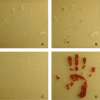Bacterial hand contamination and transfer after use of contaminated bulk-soap-refillable dispensers
- PMID: 21421792
- PMCID: PMC3126420
- DOI: 10.1128/AEM.02632-10
Bacterial hand contamination and transfer after use of contaminated bulk-soap-refillable dispensers
Abstract
Bulk-soap-refillable dispensers are prone to extrinsic bacterial contamination, and recent studies demonstrated that approximately one in four dispensers in public restrooms are contaminated. The purpose of this study was to quantify bacterial hand contamination and transfer after use of contaminated soap under controlled laboratory and in-use conditions in a community setting. Under laboratory conditions using liquid soap experimentally contaminated with 7.51 log(10) CFU/ml of Serratia marcescens, an average of 5.28 log(10) CFU remained on each hand after washing, and 2.23 log(10) CFU was transferred to an agar surface. In an elementary-school-based field study, Gram-negative bacteria on the hands of students and staff increased by 1.42 log(10) CFU per hand (26-fold) after washing with soap from contaminated bulk-soap-refillable dispensers. In contrast, washing with soap from dispensers with sealed refills significantly reduced bacteria on hands by 0.30 log(10) CFU per hand (2-fold). Additionally, the mean number of Gram-negative bacteria transferred to surfaces after washing with soap from dispensers with sealed-soap refills (0.06 log(10) CFU) was significantly lower than the mean number after washing with contaminated bulk-soap-refillable dispensers (0.74 log(10) CFU; P < 0.01). Finally, significantly higher levels of Gram-negative bacteria were recovered from students (2.82 log(10) CFU per hand) than were recovered from staff (2.22 log(10) CFU per hand) after washing with contaminated bulk soap (P < 0.01). These results demonstrate that washing with contaminated soap from bulk-soap-refillable dispensers can increase the number of opportunistic pathogens on the hands and may play a role in the transmission of bacteria in public settings.
Figures



References
-
- Amemiya K., Taguchi F. 1992. Survey of bacterial contamination of hand washing liquids. J. Antibacterial Antifungal Agents 20:459–463 (Translated from Japanese.)
-
- Archibald L. K., et al. 1997. Serratia marcescens outbreak associated with extrinsic contamination of 1% chlorxylenol soap. Infect. Control Hosp. Epidemiol. 18:704–709 - PubMed
-
- Barry M. A., Craven D. E., Goularte T. A., Lichtenberg D. A. 1984. Serratia marcescens contamination of antiseptic soap containing triclosan—implications for nosocomial infection. Infect. Control Hosp. Epidemiol. 5:427–430 - PubMed
-
- Boyce J. M., Pittet D. 2002. Guideline for hand hygiene in health-care settings. Recommendations of the healthcare infection control practices advisory committee and the HICPAC/SHEA/APIC/IDSA hand hygiene task force. Society for Healthcare Epidemiology of America/Association for Professionals in Infection Control/Infectious Diseases Society of America. MMWR Recomm. Rep. 51:1–45 - PubMed
-
- Buffet-Bataillon S., et al. 2009. Outbreak of Serratia marcescens in a neonatal intensive care unit: contaminated unmedicated liquid soap and risk factors. J. Hosp. Infect. 72:17–22 - PubMed
MeSH terms
Substances
LinkOut - more resources
Full Text Sources
Other Literature Sources
Medical
Molecular Biology Databases

